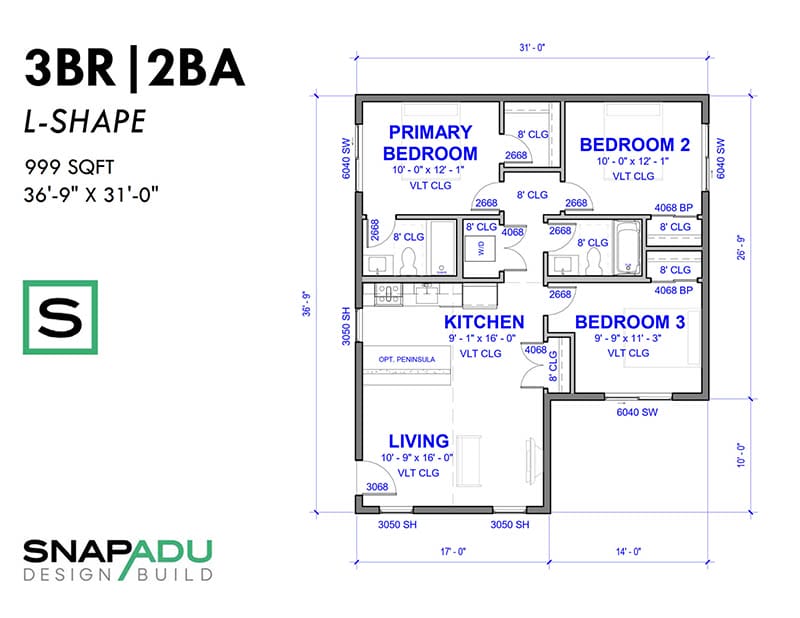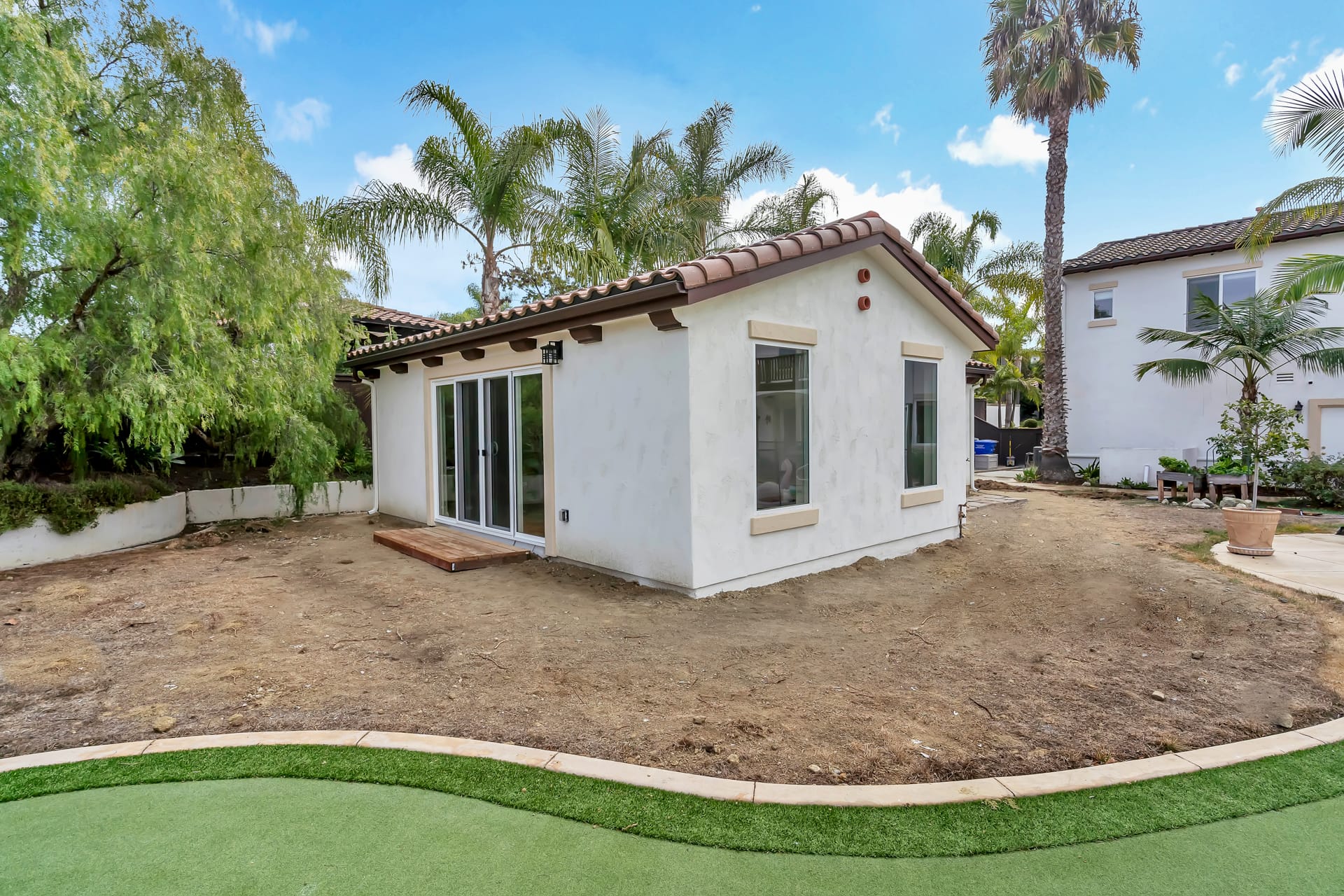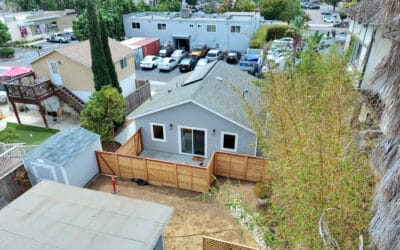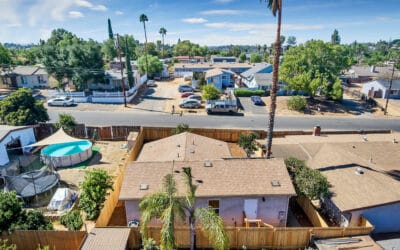You may have heard that the state of California is making an effort to move all new construction in the direction of sustainability and renewable energy.
You may also hear mixed information about whether solar is or is not required on accessory dwelling units (ADUs), and the reason for that is because the regulations have been changing… plus local jurisdictions are mixed in their interpretation & application of the code.
But don’t worry, we stay up to date on changes so you can be informed of all the key regulations and how that translates on your ADU project. Read on to learn when and why you need to install solar panels onto your new California ADU.
Do I need to install solar panels for my Accessory Dwelling Unit?
California state law requires that all new construction – including newly-built accessory dwelling units – must have solar panels, BUT there are important exemptions to this rule. In general for Greater San Diego: all small (<620 square feet) ADUs may be exempt from solar requirements, while units above that threshold in certain climate zones will require solar. Once your ADU is more than 1125 sqft, no matter what climate zone you are in, your project will need solar (unless the ADU is a conversion or an addition, as those are entirely exempt from the solar requirement).
Here are more details on this topic for those of you interested:
Specifically for newly constructed single-family buildings (including ADUs), dig deep into page 354 of the 2022 Building Energy Efficiency Standards to find Exception 2 to Section 150.1(c)14: No PV system is required when the minimum PV system size specified by section 150.1(c)14 is less than 1.8 Kw. We had this interpretation verified by the California Energy Commission Building Standards Office Outreach & Education Unit in June of 2023, and a recent Blueprint Issue 142 from the CEC also clarifies this point, “No PV system is required when the minimum PV system size is less than 1.8 kWdc, as specified by § 150.1(c)14, which uses Equation 150.1-C to determine the required minimum PV system size.”
There is an equivalent multifamily PV (photovoltaic) exemption when the minimum PV system size is less than 1.8 kW. Per the CEC’s Blueprint Issue 138, “Exception 2 to § 170.2(f) applies to each building (not individual dwelling units) if the minimum PV size specified is less than 1.8 kW, then no PV is required for that building.”
Can you tell me if I need solar on my ADU?
When you receive a proposal from SnapADU, we will be sure to look up your climate zone and perform the calculation so that we can have a reasonably accurate idea of whether your project will require solar and how large a system it will require.
Why just “reasonably accurate” idea of whether the project will require solar? The uncertainty is because we are still seeing inconsistent application of this solar requirement exemption, meaning each jurisdiction may interpret this differently. In our regular revision & permitting process, we would advocate for the homeowner in situations where we believe the state law supersedes an interpretation by the city.
How can I satisfy the solar requirement for my ADU?
The California Energy Commission (CEC) states that panels can be installed on the accessory dwelling unit or the primary unit. Adding solar panels onto new construction is common practice for California contractors, as installation is quick and easy when you are already in the process of building.
If you already have solar panels on your primary dwelling, you may add new photovoltaic (PV) modules to the existing system to meet energy code requirements for the ADU. The new PV modules must be part of the ADU’s permit application, sized per the Energy Code, and comply with other parts of the building code as applicable.
If you plan to install solar panels or expand the existing solar panel system on the primary residence to satisfy the energy requirements of the ADU, it may be the case that the new solar modules require an upgrade to your existing electrical service. In this case, it is imperative that the new solar panels or solar expansion is installed after the service upgrade is complete. Electrical service upgrades should always be performed by the ADU contractor to ensure that all measures are being met to accommodate the needs of the ADU.
How will solar affect my accessory dwelling unit cost?
The cost of installing solar depends on how many kilowatts are necessary to supply your casita with enough energy to support the amount of consumption. Solar panel design & installation on average adds around $12-18K onto the cost of your build. This is something your contractor will put into your budget during the early stages of your discussions so you can appropriately plan. The benefit of this requirement is that the solar panels will help reduce your energy bills and make your ADU more sustainable overall.
Is there a tax credit for solar in California?
Yes, the investment tax credit (ITC), also known as the federal solar tax credit, is a 30% federal residential solar energy tax credit for solar photovoltaic (PV) installations. This means a qualified homeowner can submit for the 30% tax credit when doing their tax returns. The credit is calculated on the total installed cost of the solar system, and there is no maximum amount that can be claimed.
EXAMPLE: A homeowner installs a $15K solar array in late 2022. When filing their taxes for the same year, let’s say they owe $20K of taxes in total. By claiming the tax credit of $4,500 (30% of $15k), this homeowner would only owe $15,500 in taxes for 2022 ($20K-$4,500).
Note that the Inflation Reduction Act of 2022 was passed in August and extended a larger 30% credit (previously at 26% in 2020-2021) for systems installed in 2022-2032.
What is the qualification for a solar tax credit?
- A homeowner has to own the solar system and pay federal taxes
- The solar system must be placed in service during the tax year and generate electricity for a home
- The solar system must be new and not an expansion of an existing system
How will solar affect my ADU timeline?
Solar installation and permitting, when completed during the ADU build, is carried out in parallel with the rest of the design & build process for your ADU, so no additional time will be required. The process looks very similar to the broader construction process, which includes design, permitting & installation, so your build will not be thrown off by the addition of solar.
All in all, this whole process will take between 60 and 90 days. The design process does not take much time, as it mainly involves determining how many panels are necessary to supply the whole guest home with energy. Obtaining solar permits, the next step, will take around 45 days depending on your jurisdiction. The solar permit is different from the general building permit, so the two will be submitted separately (all of that work is included in your proposal with SnapADU). Typically, the solar permit will be submitted first.
The actual install of the panels comes later in the build. The roof must be completely built before the panels can be put on. This takes about 30 days, and then must be inspected to ensure quality. Again, the entire process of solar permitting and installation is easily integrated with the rest of your granny flat build, so it is unlikely you will need to allocate any additional time for the installation. Your contractor will be sure to keep you in the loop during the entirety of the process.
How will solar affect my ADU design?
The addition of solar panels on your ADU will generally not affect the overall design of your ADU. All of our plans are designed to be solar-friendly, meaning they have a roof that will accommodate panels (a wide, flat roof). The majority of homes and accessory dwelling units have solar-friendly roofs, as it is most common to build a granny flat with a solar-ready roofline.
Custom ADUs with more unique designs, or any irregular roof, may need to reconsider where the solar panels will be installed, as a flat roof is the best design to accommodate the panels. Any special considerations will be taken into account during the design phase, so you will know up-front whether your design will comfortably fit solar panels. Once again, solar panels generally fit in all circumstances, with the exception of very custom guest house designs.
Will my existing solar panels on the main home count towards my ADU required solar?
No, an existing solar array on your primary home – without any additions – will not be counted towards the CEC requirement for adding solar panels for new construction. However, you can expand an existing solar system on your primary house to cover the energy needs of the ADU, and such expansion may be counted towards the ADU during the permitting process.
As with any law there is some room for interpretation by those checking the plans, and each municipality interprets the solar requirement a bit differently. In some cases (even within the same jurisdiction) a plan checker may allow an existing solar array on the main home to count towards the ADU while another plan checker may not. San Marcos and Escondido will specifically not accept existing solar systems as counting towards the requirement, and we have also seen this happen in San Diego. As such, we can see inspectors moving towards universally enforcing the CEC requirements for new solar when adding an ADU.
As of December 2022, the County of San Diego Building Division confirmed the following for expanding the solar on the main home: “For an existing solar system, our building inspector will confirm the size is adequate to support the ADU during inspection. No need to designate this on the permit to expand the solar system. Please ensure the size of the system matches the energy compliance forms (i.e., CF1R).”
If I already have solar on my main home on NEM 2.0, would building an ADU get me kicked off NEM 2.0?
As long as the existing solar on the property remains unchanged and on the meter it is currently feeding, it will stay within NEM 2.0. We can upgrade the electrical service as well while keeping him in NEM 2.0. However, the ADU solar will feed a separate meter which will be subject to NEM 3.0.
Under NEM 3.0, the utility company pays you a reduced rate for the excess power that your solar panels produce, compared to the more favorable rates under NEM 2.0. Additionally, NEM 3.0 includes peak-time premium charges, typically from 4 PM to 9 PM, which can significantly reduce the effectiveness of your solar system in eliminating your power bill.
The Solution: Add a Battery
To maximize your savings and maintain the utility of your solar investment, consider adding a battery storage system to your solar setup. With a battery, the excess solar power produced during the day is stored rather than sent back to the grid for a lower compensation rate. Then, during peak times when electricity costs are higher, your system will discharge from the battery instead of drawing expensive electricity from the grid. This results in a significantly greater reduction in your power bill. The cost to add battery backup would be starting from around $8,500, and you could choose to add outage backup, generator input, or extra battery banks. These would be wall-mounted and go on the exterior of the ADU adjacent to the electrical panels.
Could I have my own solar vendor install a system on the ADU?
Unfortunately we cannot have outside vendors work on any components of the ADU due to liability as well as logistics. Specifically, the solar (PV) system design is integrated with the ADU electrical design, connection lines to the main service panel, as well as components to the main service panel itself. While it is possible to design and install these various aspects of the electrical system independently, it has proven to be extremely problematic in our experience. So for this reason, our solar vendor who designs all of these systems also executes the installation.
Does an ADU need Title 24?
Yes, Title 24 requires that all new construction – including accessory dwelling units – must meet energy consumption thresholds. Title 24 of California state law refers to a number of regulations California has put in place to ensure energy conservation, including solar requirements. Read more about what Title 24 means for ADUs.
All in all, new California ADUs must have solar panels to reduce the energy consumption of the structure being built. This requirement is carried out under Title 24 of California state law, which seeks to ensure energy is being consumed responsibly and as conservatively as possible. The process of permitting and installing solar is simple, and can be carried out alongside the ADU permitting and building process. This usually takes between 60 and 90 days. Most ADU designs will comfortably accommodate solar panels, with the exception of irregular, uncommon designs. In those cases, your contractor will be able to walk you through the alternatives available to you.
Reach out to experts for your unique situation
The information provided in this blog is based on our extensive experience in design, permitting, and building ADUs, as well as our thorough knowledge of local and state regulations up until now. It’s important to note that regulations may vary in different areas, and local interpretations can differ. There are also small nuances to watch out for, like obtaining your ADU address so your solar system can be registered.
We strive to anticipate the most common scenarios and interpretations to provide accurate advice on budget and scope to our clients. Our goal is to ensure that there are no surprises, particularly when it comes to costs and the overall process. However, we do hope that you’ll be pleasantly surprised by how smoothly things go and how amazing your ADU looks upon completion!






Hi,
I got 7.6kw system solar panel on my main house 1200 sqft and planning on building a 500sqft ADU with their own metering unit. I live in city of westminster CA wondering if i still have to add solar to the Adu or do i have to add more to my main house.
A 500 sqft ADU would be exempt from the solar requirements based on your specific zip code and ADU size. See page 354 of the 2022 Building Energy Efficiency Standards to find Exception 2 to Section 150.1(c)14: No PV system is required when the minimum PV system size specified by section 150.1(c)14 is less than 1.8 Kw. Page 360 of that document shows the inputs for the formula, and you can verify your climate zone by zip code here.
I just had a new 625 sq ft ADU approved without Solar in Long Beach. All these companies saying its mandatory are full of it! Its all based on energy Consumption. Figure out how to stay under the min and your good. Just talk to a Title 24 energy consultant. They will tell you what you need to do to avoid paying for solar.
Yes, fully agree it is important to understand your climate zone and ADU size, then calculate if solar will be required. Some ADUs as large as 1100 sqft may not need solar if they are in climate zone 7, for example. Keep in mind this carve out from the CEC is new as of 2023, so there were a few years where solar was mandated for ALL ADUs (and we had half a dozen different city inspectors require it for occupancy, even if we had a permitted set of plans without solar). All this points to one fact: ADUs are a tricky space, as state and local regulations are constantly evolving.